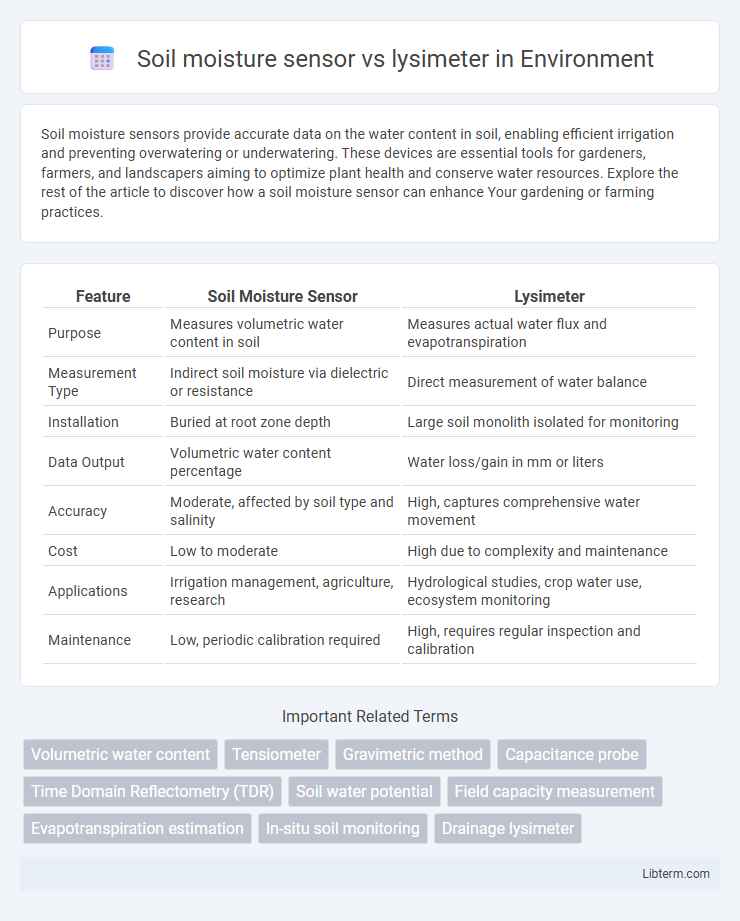Soil moisture sensors provide accurate data on the water content in soil, enabling efficient irrigation and preventing overwatering or underwatering. These devices are essential tools for gardeners, farmers, and landscapers aiming to optimize plant health and conserve water resources. Explore the rest of the article to discover how a soil moisture sensor can enhance Your gardening or farming practices.
Table of Comparison
| Feature | Soil Moisture Sensor | Lysimeter |
|---|---|---|
| Purpose | Measures volumetric water content in soil | Measures actual water flux and evapotranspiration |
| Measurement Type | Indirect soil moisture via dielectric or resistance | Direct measurement of water balance |
| Installation | Buried at root zone depth | Large soil monolith isolated for monitoring |
| Data Output | Volumetric water content percentage | Water loss/gain in mm or liters |
| Accuracy | Moderate, affected by soil type and salinity | High, captures comprehensive water movement |
| Cost | Low to moderate | High due to complexity and maintenance |
| Applications | Irrigation management, agriculture, research | Hydrological studies, crop water use, ecosystem monitoring |
| Maintenance | Low, periodic calibration required | High, requires regular inspection and calibration |
Overview of Soil Moisture Sensors and Lysimeters
Soil moisture sensors measure volumetric water content in the soil using techniques like capacitance, TDR, or neutron scattering, providing real-time data critical for irrigation management and agricultural optimization. Lysimeters, on the other hand, quantify water balance components by isolating a soil volume to measure percolation, evapotranspiration, and drainage, offering precise insights into water fluxes over time. Both tools are essential for comprehensive soil water monitoring, with sensors enabling continuous, localized moisture assessment and lysimeters delivering integrative, field-scale water movement data.
Fundamental Principles of Operation
Soil moisture sensors operate by measuring the volumetric water content through dielectric permittivity or electrical resistance changes in the soil. Lysimeters assess soil moisture by collecting and quantifying percolated water, providing direct measurements of water balance and evapotranspiration. The fundamental difference lies in soil moisture sensors offering instantaneous, localized humidity data, while lysimeters provide integrated, physical water flux measurements over time.
Key Differences in Measurement Techniques
Soil moisture sensors measure volumetric water content directly by detecting the dielectric constant of the soil using techniques such as time domain reflectometry (TDR) or capacitance sensors. Lysimeters determine water measurement indirectly by weighing soil columns to assess water loss through evapotranspiration and leaching, providing integrative water balance data over time. While soil moisture sensors offer localized, real-time moisture levels, lysimeters deliver comprehensive water flux insights at a larger scale, highlighting fundamental differences in their measurement techniques.
Installation and Maintenance Requirements
Soil moisture sensors offer easy installation with minimal disturbance, often requiring simple insertion or embedding at target depths, making them suitable for rapid deployment and frequent monitoring. Lysimeters demand complex installation, including excavation and precise sealing to ensure accurate water balance measurements, which often involves higher labor and equipment costs. Maintenance for soil moisture sensors is generally low, involving periodic calibration and cleaning, whereas lysimeters require regular inspection and maintenance of drainage systems to prevent clogging and ensure data accuracy.
Accuracy and Data Reliability
Soil moisture sensors provide real-time measurements with high spatial resolution but may suffer from sensor drift and environmental interferences, affecting long-term accuracy. Lysimeters offer comprehensive and highly accurate water balance data by directly measuring evapotranspiration and deep percolation, ensuring superior data reliability for hydrological studies. Combining both tools enhances overall precision, with soil moisture sensors delivering granular temporal data and lysimeters validating these measurements through physical water flux observations.
Cost Comparison and Budget Considerations
Soil moisture sensors typically offer a more cost-effective solution for monitoring soil water content, with prices ranging from $50 to $200 depending on accuracy and features, making them suitable for budget-conscious projects. Lysimeters, however, involve higher initial investments often exceeding $1,000 due to their complex design and precision measurement capabilities, which can strain limited budgets but provide in-depth water balance data. Budget considerations should weigh the balance between affordable, frequent data from soil moisture sensors and the comprehensive, high-cost insights provided by lysimeters.
Applications in Agriculture and Research
Soil moisture sensors provide real-time data on volumetric water content, enabling precision irrigation management to enhance crop yield and conserve water resources in agriculture. Lysimeters offer accurate measurement of evapotranspiration and percolation rates, supporting research on plant-water relations and nutrient leaching in controlled field conditions. Both tools are essential for optimizing water use efficiency and improving soil health monitoring in agricultural research and practice.
Response Time and Data Resolution
Soil moisture sensors provide real-time data with rapid response times, often measuring moisture levels within seconds to minutes, enabling continuous monitoring of soil water content at high temporal resolution. Lysimeters, while offering precise measurements of water flux and evapotranspiration, typically have slower response times due to their reliance on weighing mechanisms and periodic data extraction, resulting in lower temporal resolution compared to soil moisture sensors. The high-frequency data from soil moisture sensors allows for detailed soil moisture dynamics analysis, whereas lysimeters provide more integrative, less frequent insights valuable for long-term water balance studies.
Challenges and Limitations of Each Method
Soil moisture sensors face challenges such as limited accuracy in heterogeneous soils and calibration requirements for different soil types and salinity levels. Lysimeters, while highly precise for measuring water balance and evapotranspiration, are expensive, labor-intensive, and often limited to small-scale agricultural research settings. Both methods struggle with spatial variability representation, making it difficult to scale results for large or diverse landscapes.
Choosing the Right Solution for Your Needs
Soil moisture sensors offer real-time data on water content at various soil depths, providing efficient monitoring for irrigation management and precision agriculture. Lysimeters measure actual water drainage and evapotranspiration, delivering comprehensive insights for hydrological studies and water balance assessments. Selecting the right solution depends on your objectives: choose soil moisture sensors for quick, localized moisture readings and lysimeters for detailed, whole-system water flow analysis.
Soil moisture sensor Infographic

 libterm.com
libterm.com